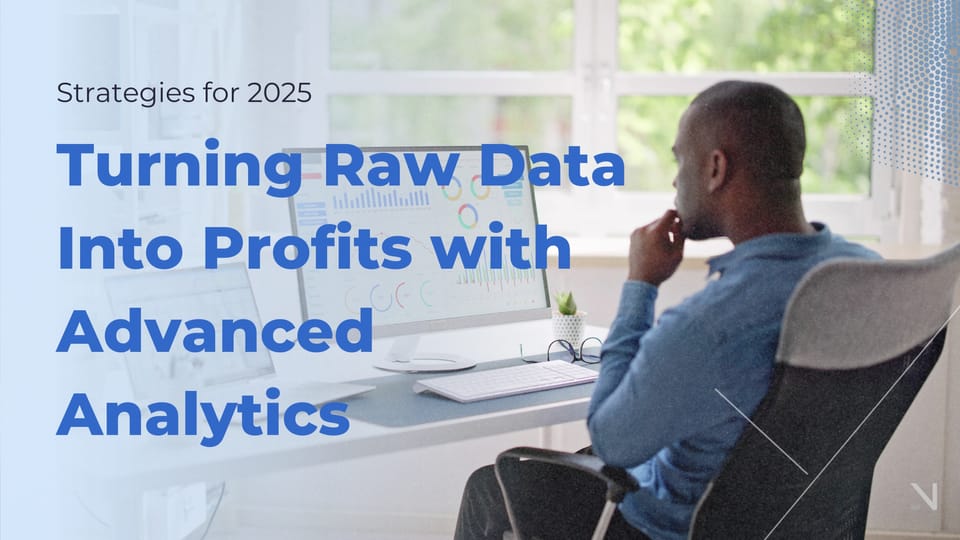Turning Raw Data Into Profits: Advanced Analytics Strategies for 2025
Narima Digital •

Have you ever looked at the sheer amount of data your business collects and thought, “What do I even do with all this?” You’re not alone. At Narima, we’ve met many business owners and decision-makers who know their data has value but aren’t sure how to unlock it. That’s where advanced analytics comes in. By 2025, these strategies won’t just be optional—they’ll be essential for staying competitive. Let’s explore how businesses can turn raw data into profits and operational excellence.
Seeing the Future: Predictive Analytics in Action
Imagine this: A retailer uses historical data and predictive algorithms to prepare for the holiday season. Based on past buying patterns, weather forecasts, and even local events, they know exactly how much stock to order for each store. This isn’t a wild guess; it’s the power of predictive analytics.
Predictive analytics takes the data you already have and uses it to forecast what’s likely to happen next. Think of it as a crystal ball powered by math and machine learning. For example, in sales, it can identify trends that help you stock the right products at the right time. In customer service, it might reveal which clients are at risk of leaving, giving you the chance to act before it’s too late.
At Narima, we’ve seen businesses use predictive analytics to save millions in inventory costs and improve customer retention by targeting at-risk accounts. If you’re new to this, start with a single problem you want to solve. Maybe it’s forecasting demand or predicting churn. Once you see the results, you’ll understand why so many companies are investing in this technology.
From Insight to Action: Prescriptive Analytics
Now, let’s take it a step further. Knowing what’s likely to happen is helpful, but wouldn’t it be better if your data could tell you exactly what to do? That’s the role of prescriptive analytics.
Imagine you run a delivery service. A snowstorm is forecasted in one of your key regions. With prescriptive analytics, your system could recommend rerouting deliveries, reallocating drivers, and adjusting timelines. It doesn’t just predict the problem; it gives you a plan to tackle it.
This type of analytics is especially powerful in industries with dynamic pricing, like travel and e-commerce. Airlines, for example, use prescriptive analytics to adjust ticket prices in real-time based on demand, competition, and other factors. But it’s not just for giants. Small businesses can use similar strategies to optimize resources and reduce costs. Imagine having a digital advisor that helps you make the best decisions every day—that’s what prescriptive analytics offers.
Telling a Story with Data: The Art of Visualization
Data, by itself, can be overwhelming. Numbers and spreadsheets don’t inspire action—stories do. That’s why data visualization is such a game-changer.
Think of it this way: You’re presenting a quarterly sales report to your team. Instead of drowning them in rows of numbers, you show a clean, interactive dashboard. It highlights top-performing products, regions with untapped potential, and areas where margins are slipping. Suddenly, everyone in the room understands the story the data is telling.
At Narima, we recommend tools like Tableau or Power BI to our clients. But the key isn’t just the software—it’s knowing which metrics matter most. Focus on KPIs that drive decisions, like customer acquisition costs or supply chain efficiency. And remember, simplicity is powerful. A clear chart or graph can communicate more than pages of text ever could.
Making Every Second Count: Real-Time Analytics
Imagine you’re managing a warehouse. Suddenly, a spike in orders comes through. Real-time analytics alerts you immediately, allowing you to mobilize extra staff, prioritize shipments, and avoid delays. This isn’t a scenario for the future—it’s happening right now with companies that embrace real-time analytics.
In today’s fast-paced business world, acting on data in the moment is a huge advantage. It’s not just for logistics. Retailers use real-time analytics to track in-store behavior, adjusting displays and promotions based on what customers are buying. Customer service teams monitor live sentiment analysis to resolve issues before they escalate. The opportunities are endless.
Real-time analytics requires robust systems, but the payoff is worth it. It keeps you agile, responsive, and ready to seize opportunities as they arise. At Narima, we’ve helped businesses integrate real-time analytics into their operations with transformative results.
Empowering Your Team with Data
Here’s the thing about data: It’s only valuable if people can use it. That’s why democratizing data is so important. Your sales team, marketing department, and operations staff should all have access to insights that help them make better decisions.
One of our clients, a mid-sized manufacturer, struggled with siloed data. Their teams spent hours hunting for information instead of acting on it. By implementing an integrated analytics platform, we made it easy for everyone to find what they needed. The result? Faster decisions, better collaboration, and a more data-driven culture.
The key is to provide tools that are intuitive and easy to use. Not everyone needs to be a data scientist, but they should feel confident interpreting the metrics relevant to their role. Training and clear data governance policies also go a long way in building trust and competence across your organization.
The Future of Advanced Analytics
As we look ahead to 2025, the role of advanced analytics will only grow. The amount of data available to businesses is increasing exponentially, and those who can harness it effectively will lead their industries. AI and machine learning will become even more accessible, enabling smaller companies to compete with larger players. And customer expectations for personalized, data-driven experiences will continue to rise.
If you’re ready to turn your raw data into profits, Narima is here to help. Whether you’re starting from scratch or looking to optimize your existing systems, we’ll work with you to design strategies that deliver real results. Let’s build a smarter, more data-driven future together.


